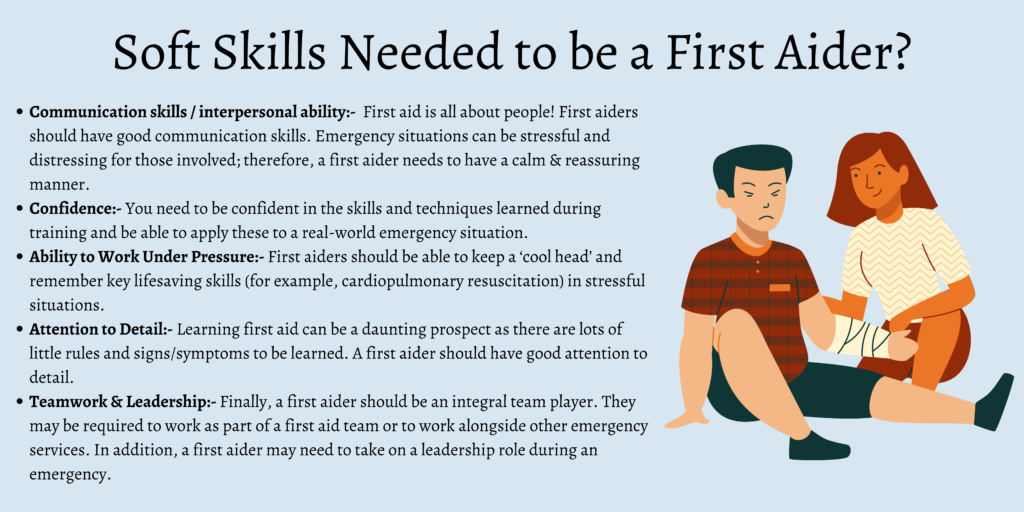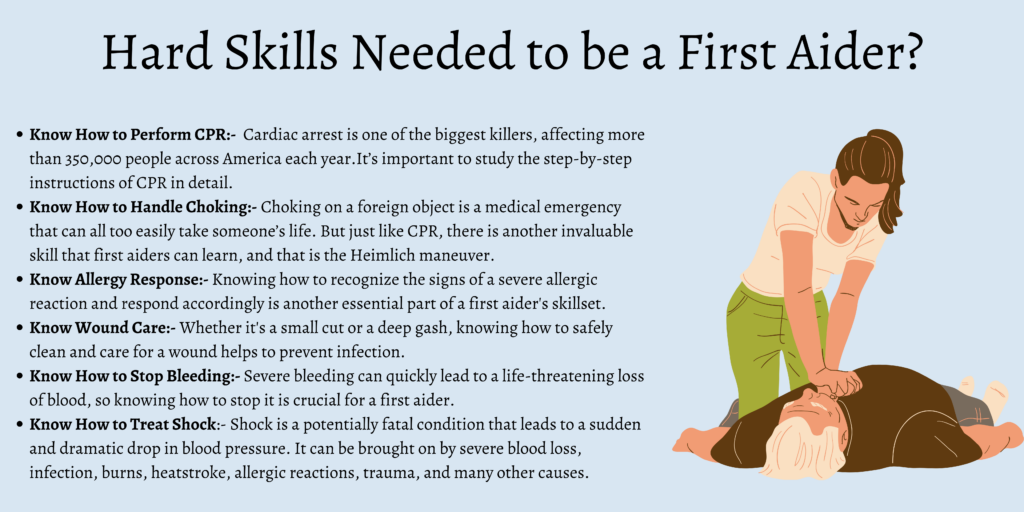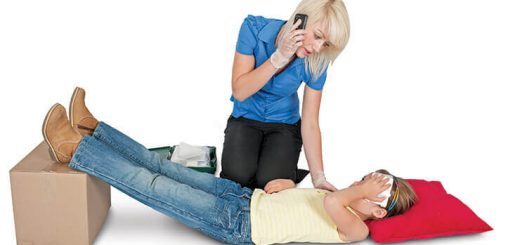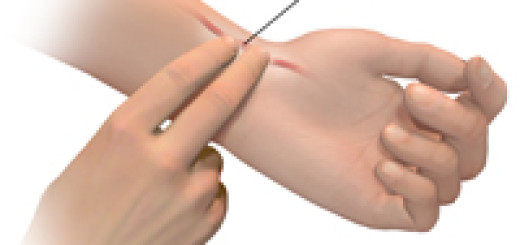What Are The Skills Needed to be a First Aider?
So what skills do you need to be a first aider? Here’s our take on the skills required to become a great first aider:
Soft First Aid Skills
First, let’s examine some of the personality traits (known as soft skills) you will need to be a great first aider.
Communication skills / interpersonal ability
First aid is all about people! First aiders should have good communication skills. Emergency situations can be stressful and distressing for those involved; therefore, a first aider needs to have a calm & reassuring manner.
In addition, a good first aider needs to be able to ask appropriate questions about signs and symptoms. This can be a challenge if a patient is scared or in pain!
Confidence
We believe a certain amount of confidence is required to be a first aider. You need to be confident in the skills and techniques learned during training and be able to apply these to a real-world emergency situation.
Ability to Work Under Pressure
First aiders may be called upon to make decisions or act in emergency situations. Therefore, the ability to work under pressure is critical. First aiders should be able to keep a ‘cool head’ and remember key lifesaving skills (for example, cardiopulmonary resuscitation) in stressful situations.
Attention to Detail
A certain amount of attention to detail is required to become a first aider. Learning first aid can be a daunting prospect as there are lots of little rules and signs/symptoms to be learned. A first aider should have good attention to detail.
Teamwork & Leadership
Finally, a first aider should be an integral team player. They may be required to work as part of a first aid team or to work alongside other emergency services. In addition, a first aider may need to take on a leadership role during an emergency.
So, there you have it; these are some of the most important personal skills you’ll need to succeed as a first aider.
But of course, first aid is much more than being a confident team player with good communication skills, attention to detail, and the ability to work under pressure. You’ll also need some knowledge-based skills (known as hard skills) that could save somebody’s life.
Hard First Aid Skills
Here are some of the most important hard skills you should learn to become a great first aider.
Know How to Perform CPR
Cardiac arrest is one of the biggest killers, affecting more than 350,000 people across America each year. But a cardiac arrest doesn’t have to mean a death sentence. If more people learned lifesaving cardiopulmonary resuscitation (CPR) skills, then many lives could be saved.
To learn the components of high-quality CPR, read our in-depth guide here. And to test your existing CPR knowledge, take our free quiz here.
It’s important to study the step-by-step instructions of CPR in detail, but here’s a quick overview.
- Administer 30 chest compressions in quick succession (at a rate of around 100-120 per minute).
- Administer 2 rescue breaths before immediately resuming chest compressions.
- Continue this cycle for a minimum of 20 minutes or until professional medical help arrives.
Know How to Handle Choking
Choking on a foreign object is a medical emergency that can all too easily take someone’s life. But just like CPR, there is another invaluable skill that first aiders can learn, and that is the Heimlich maneuver.
The Heimlich maneuver is designed to be used on adults in a choking emergency when the victim cannot talk, cough, or breathe. If they are unable to do these three things, their airway is blocked, and they need immediate first aid assistance in the form of the Heimlich maneuver.
The Heimlich maneuver involves standing behind the casualty, wrapping your arms around the front of your torso, and placing one fist just above the belly button area. Then, with a fast and forceful thrust, pull your fist inwards and upwards toward you.
For more full and detailed instructions on how to perform the Heimlich maneuver, click here.
Know Allergy Response
Knowing how to recognize the signs of a severe allergic reaction and respond accordingly is another essential part of a first aider’s skillset.
People can be allergic to many different things, but some common allergens that can have life-threatening consequences include stings, bites, certain medications, and food items such as nuts, dairy, shellfish, and eggs.
Signs of an allergic reaction include rash, itchiness, and swelling of the face and the extremities. But while these symptoms are unpleasant, they can be dangerous or downright fatal if anaphylaxis sets in and swelling obstructs a person’s airway.
If you notice any of the symptoms above, dial 911 (or your national equivalent emergency number).
If the person knows they have a severe allergy, there’s a good chance that they’re carrying an auto-injector, sometimes called an EpiPen. This will administer a potentially lifesaving dose of adrenaline. Just follow the simple step-by-step instructions on the packaging.
Know Wound Care
Whether it’s a small cut or a deep gash, knowing how to safely clean and care for a wound helps to prevent infection.
There are many different types of wounds, but the general principles of hygiene apply to them all. Always thoroughly wash your hands with soap and water before touching a wound, and wear medical-grade gloves where available.
Next, use a clean absorbent material, such as gauze or paper towel, to press against the wound until the bleeding stops. Then, rinse the wound under cool running water to clean away any dirt or debris that may be embedded, which could cause infection.
Finally, apply an over-the-counter antibiotic cream before applying a suitable bandage. For more detailed instructions on the first aid skills needed to treat cuts and wounds, read our guide here.
Know How to Stop Bleeding
Severe bleeding can quickly lead to a life-threatening loss of blood, so knowing how to stop it is crucial for a first aider.
If you witness an accident or injury that results in severe bleeding, apply firm pressure to the source of the bleeding. Ideally, you will use a clean and sterile cloth for this; however, in a real-life emergency, this type of medical-grade equipment isn’t always available.
In this case, articles of clothing like tee shirts, or any other nearby absorbent material, will also work. If the blood continues to flow, do not remove the cloth from the wound. Instead, add more layers and continue to apply firm pressure.
Wounded limbs can be raised above the heart to slow down heavy bleeding. Plus, as a last resort, you can make a tourniquet to achieve the same result. For more in-depth information about stopping bleeding and supplementary measures that can help, read our comprehensive guide here.
Know How to Treat Shock
Shock is a potentially fatal condition that leads to a sudden and dramatic drop in blood pressure. It can be brought on by severe blood loss, infection, burns, heatstroke, allergic reactions, trauma, and many other causes.
When someone is suffering from shock, their blood flow reduces, and their vital organs quickly become starved of oxygen. So, it’s essential to act quickly.
The signs and symptoms of shock include:
- Cold, pale, and clammy skin
- A grayish-blue tint to the skin inside the lips
- Excessive sweating
- A fast heart rate which increases further as shock sets in
- A weak pulse
- Rapid, shallow breathing
- Yawning
- Nausea and vomiting
- Gasping for air
Treating shock involves identifying and fixing the primary cause.
For a full detailed guide on shock and what to do in a shock-related emergency, read our in-depth blog post here.
Conclusion
If you want to learn first aid or brush up on your existing first aid knowledge, there are several skills you’ll need. The list above is by no means exhaustive, and there are plenty of other important components to becoming an effective first responder. However, these skills are a great base to build upon, and who knows, one day, they could help you save somebody’s life.







